|
MERCURY COUGAR History
Introduction: The
Mercury Cougar was introduced in 1967 as the more upscale version of the
Ford Mustang. It had more mature styling and upscale interior appointments
and rode on a three inch longer wheelbase than the Mustang. Yet despite
its greater emphasis on luxury than performance, the Mercury Cougar still
managed to make its mark on the American street scene.
1967 Mercury Cougar
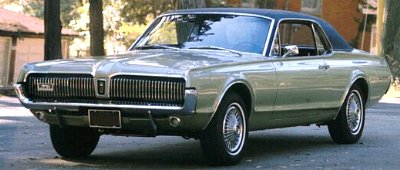 Comments:
Mercury joined the pony car race full speed with its Cougar, based on a
stretched version of the Ford Mustang. Only a two door hardtop was available
with standard simulated leather bucket seats, hideaway headlights, and
a V8 engine, impressive enough to be named Motor Trend's Car of the Year.
Two trim packages were also available, available separately or together.
The XR-7 package included a wood-rimmed steering wheel, black-face competition-type
instrumentation in a simulated walnut dash, toggle switches, an overhead
console, a leather-covered T-handle automatic transmission shifter, and
combination leather/vinyl seats. For performance buyers, the GT package,
a 3 option, included a firmer suspension with solid rear brushings,
stiffer springs all around, bigger 1.1875 inch shocks, a fatter 0.84 inch
anti-roll bar, power front disc brakes, 8.95x14 Wide-Oval tires, a low-restriction
exhaust system and special identification features. Standard with the GT
package was a 390 cid V8 rated at 335 bhp. The 390 used hydraulic lifters,
a fairly mild cam and "street type" valve timing that resulted in a favorable
1:10 power-to-weight ratio. A Holley C70F carb with four 1.562 inch venturies
and vacuum-operated secondaries sat on the 390 cid engine. With a 10.5:1
compression ratio, it required premium fuel. Transmission choices included
three or four speed synchro gearboxes or a three-speed Merc-O-Matic with
manual shift capabilities for down-shifting to second below 71 mph or first
below 20 mph. While based on the Mustang platform, the Cougar's suspension
was upgraded with a hook-and-eye joint the lower front A frames to dampen
ride harshness, six-inch-longer rear leaf springs, and better-rated rear
spring and axle attachments. The GT, however, came with the manual transmissions
used with the 390 were different from those used with the 289. The 390
came standard with a 3.00:1 rear axle, while a 3.25:1 "Power Transfer"
axle was optional. Comments:
Mercury joined the pony car race full speed with its Cougar, based on a
stretched version of the Ford Mustang. Only a two door hardtop was available
with standard simulated leather bucket seats, hideaway headlights, and
a V8 engine, impressive enough to be named Motor Trend's Car of the Year.
Two trim packages were also available, available separately or together.
The XR-7 package included a wood-rimmed steering wheel, black-face competition-type
instrumentation in a simulated walnut dash, toggle switches, an overhead
console, a leather-covered T-handle automatic transmission shifter, and
combination leather/vinyl seats. For performance buyers, the GT package,
a 3 option, included a firmer suspension with solid rear brushings,
stiffer springs all around, bigger 1.1875 inch shocks, a fatter 0.84 inch
anti-roll bar, power front disc brakes, 8.95x14 Wide-Oval tires, a low-restriction
exhaust system and special identification features. Standard with the GT
package was a 390 cid V8 rated at 335 bhp. The 390 used hydraulic lifters,
a fairly mild cam and "street type" valve timing that resulted in a favorable
1:10 power-to-weight ratio. A Holley C70F carb with four 1.562 inch venturies
and vacuum-operated secondaries sat on the 390 cid engine. With a 10.5:1
compression ratio, it required premium fuel. Transmission choices included
three or four speed synchro gearboxes or a three-speed Merc-O-Matic with
manual shift capabilities for down-shifting to second below 71 mph or first
below 20 mph. While based on the Mustang platform, the Cougar's suspension
was upgraded with a hook-and-eye joint the lower front A frames to dampen
ride harshness, six-inch-longer rear leaf springs, and better-rated rear
spring and axle attachments. The GT, however, came with the manual transmissions
used with the 390 were different from those used with the 289. The 390
came standard with a 3.00:1 rear axle, while a 3.25:1 "Power Transfer"
axle was optional.
Production: 2D Hardtop:
116,260 GT 2D Hardtop: 7,412 XR-7 2D Hardtop: 27,221
Engines: 289 V8 195
bhp. 289 V8 200 bhp. 289 V8 225 bhp. 390 V8 280 bhp. 390 V8 320 bhp. 390
V8 335 bhp @ 4800 rpm, 427 lb-ft @ 3200 rpm.
Performance: 390/335:
0-60 in 8.1 seconds, 1/4 mile in 16 seconds.
1968 Mercury Cougar
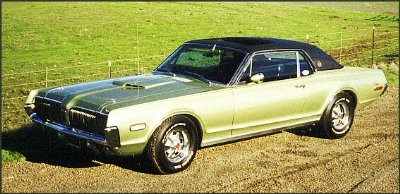 Comments:
Mercury got serious with performance with the introduction of the GT-E.
It initially came with the mild 390 bhp E version of the 427 cid V8 with
SelectShift Merc-O-Matic, the performance handling package, styled steel
wheels, power disc brakes, a power dome, and non-functional hood scoop.
The 427 equiped Cougar was nose heavy and thus suffered in acceleration
runs. But later in the 1968 model year, the 427 was replaced with the new
corporate 428 engine. To keep insurance agents happy, the 428 was rated
at 335 bhp, although most experts believed it was closer to the same 390
bhp as the 427-E. The longer stroke 428 engine had an easier time with
emission requirements and would carry the Mercury performance banner. Comments:
Mercury got serious with performance with the introduction of the GT-E.
It initially came with the mild 390 bhp E version of the 427 cid V8 with
SelectShift Merc-O-Matic, the performance handling package, styled steel
wheels, power disc brakes, a power dome, and non-functional hood scoop.
The 427 equiped Cougar was nose heavy and thus suffered in acceleration
runs. But later in the 1968 model year, the 427 was replaced with the new
corporate 428 engine. To keep insurance agents happy, the 428 was rated
at 335 bhp, although most experts believed it was closer to the same 390
bhp as the 427-E. The longer stroke 428 engine had an easier time with
emission requirements and would carry the Mercury performance banner.
Also new for 1968 was a
new model option, the XR-7G. The "G" stood for American racing hero, Dan
Gurney, who raced for Mercury at the time. This was a one year model as
Gurney left for Plymouth in 1969. The "G" package was available on any
Cougar and included a fiber glass hood scoop, road lamps, a racing mirror,
hood pins, and the new optional sun roof. Four exhaust tips exited through
the rear valance panel and new spoke pattern styled wheels held radial
FR70-14 tires. A special emblem graced the instrument panel, roof pillar,
deck lid, and grille. The "G" cougars were not widely promoted and few
were made and even fewer exist today.
Production: 2D Hardtop:
81,014 XR-7 Hardtop: 32,712
Engines: 289 V8 195
bhp. 289 V8 200 bhp. 289 V8 225 bhp. 302 V8 210 bhp. 302 V8 230 bhp. 390
V8 280 bhp. 390 V8 320 bhp. 390 V8 335 bhp @ 4800 rpm, 427 lb-ft @ 3200
rpm. 427 V8 390 bhp. 428 V8 335 bhp.
1969 Mercury Cougar
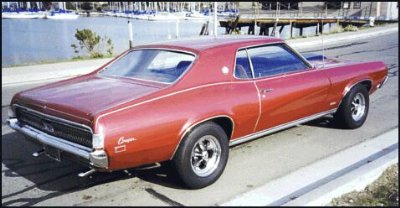 Comments:
The Mercury Cougar was wider, longer, and heavier for 1969, but a new convertible
body style joined the two door hardtop and the Cougar received a serious
performance boost mid year with the introduction of the Eliminator package.
The Eliminator came standard with the four barrel version of the Windsor
351 cid V8, rated at 290 bhp. Optional was a full range of engines from
the Trans Am inspired solid-lifter 302 seriously under-rated at 290 bhp
and the 428 Cobra Jet, with and without Ram Air. In all out acceleration,
the 290 bhp 302 cid V8 was overmatched by the Cougar's weight, but the
428 Cobra Jet benefited from the relatively generous wheelbase. Grip was
better off the line that the Mustang and 1/4 mile times were just as good.
Standard Eliminator equipment included F70x14 in Goodyear Polyglas tires
on styled steel wheels with blank center caps. The Eliminator was also
available in Drag Pak guise with an oil cooler and a 4.30:1 Detroit locker.
Eliminator didn't use the shaker hood; its standard scoop was functional
only when Ram Air was ordered. A black-out grille, side stripe, and front
and rear spoilers enhanced the look, and Mercury offered the Eliminator
in a palette of "high impact" blue, orange, and yellow exterior colors.
Even more performance was available over the dealer's parts counters, which
offered not only headers and dual quads, but such exotic hop-ups as deep-sump
oil pans and quadruple-carb Weber setups. All from Mercury! Comments:
The Mercury Cougar was wider, longer, and heavier for 1969, but a new convertible
body style joined the two door hardtop and the Cougar received a serious
performance boost mid year with the introduction of the Eliminator package.
The Eliminator came standard with the four barrel version of the Windsor
351 cid V8, rated at 290 bhp. Optional was a full range of engines from
the Trans Am inspired solid-lifter 302 seriously under-rated at 290 bhp
and the 428 Cobra Jet, with and without Ram Air. In all out acceleration,
the 290 bhp 302 cid V8 was overmatched by the Cougar's weight, but the
428 Cobra Jet benefited from the relatively generous wheelbase. Grip was
better off the line that the Mustang and 1/4 mile times were just as good.
Standard Eliminator equipment included F70x14 in Goodyear Polyglas tires
on styled steel wheels with blank center caps. The Eliminator was also
available in Drag Pak guise with an oil cooler and a 4.30:1 Detroit locker.
Eliminator didn't use the shaker hood; its standard scoop was functional
only when Ram Air was ordered. A black-out grille, side stripe, and front
and rear spoilers enhanced the look, and Mercury offered the Eliminator
in a palette of "high impact" blue, orange, and yellow exterior colors.
Even more performance was available over the dealer's parts counters, which
offered not only headers and dual quads, but such exotic hop-ups as deep-sump
oil pans and quadruple-carb Weber setups. All from Mercury!
Production: 2D Hardtop:
66,331 Convertible: 5,796 XR-7 2D Hardtop: 23,918 XR-7 Convertible: 4,024
Engines: 302 V8 290
bhp. 351 V8 250 bhp. 351 V8 290 bhp. 390 V8 320 bhp. 428 V8 335 bhp @ 5200
rpm, 440 lb-ft @ 3400 rpm.
Performance: 428/335:
0-60 in 5.6 seconds, 1/4 mile in 14.1 seconds @ 103 mph.
1970 Mercury Cougar
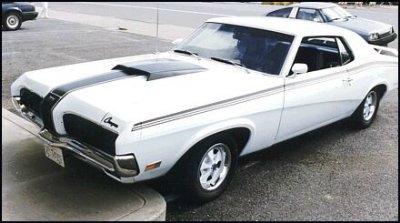 Comments:
The 1970 Mercury Cougar was even larger than the year before and sported
new styling. Returning was the Eliminator, now with a standard 351 Cleveland
four-barrel carb rated at 300 bhp. Optional engines included the Boss 302,
428 CJ and a new big block, the 429 V8 with Ram-Air induction and 375 bhp.
Despite these improvements, sales continued to decline. Comments:
The 1970 Mercury Cougar was even larger than the year before and sported
new styling. Returning was the Eliminator, now with a standard 351 Cleveland
four-barrel carb rated at 300 bhp. Optional engines included the Boss 302,
428 CJ and a new big block, the 429 V8 with Ram-Air induction and 375 bhp.
Despite these improvements, sales continued to decline.
Production: 2D Hardtop:
49,479 Convertible: 2,322 XR-7 2D Hardtop: 18,565 XR-7 Convertible: 1,977
Engines: 302 V8 290
bhp. 351 V8 300 bhp. 428 V8 335 bhp @ 5200 rpm, 440 lb-ft @ 3400 rpm.
1971 Mercury Cougar
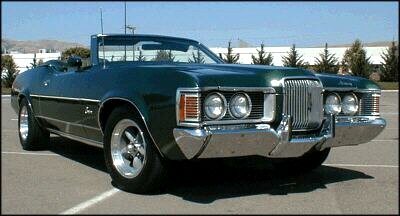
Comments: The 1971
Cougars were enlarged again, now with a 112 inch wheelbase. Although the
429 V8 was still offered, luxury not performance was stressed and previous
performance offerings like the Eliminator were eliminated.
Production: 2D Hardtop:
34,008 Convertible: 1,723 XR-7 2D Hardtop: 25,416 XR-7 Convertible: 1,717
Engines: 351 V8 285
bhp. 429 V8 370 bhp.
1972 Mercury Cougar
Comments: 1972 saw
the further decline of Cougar performance with the elimination of the 429
block, leaving the 351 as the sole engine choice. Horsepower was rated
in the new industry standard SAE net horsepower, which amplified the drop
in performance.
Production: 2D Hardtop:
23,731 Convertible: 1,240 XR-7 2D Hardtop: 26,802 XR-7 Convertible: 1,929
Engines: 351 V8 168
bhp (net). 351 V8 262 bhp (net). 351 V8 266 bhp (net).
1973 Mercury Cougar
Comments: 1973 was
the last year for the Mercury Cougar as a real pony car. In latter years,
Mercury would apply the Cougar name on a variety of Mercury models, from
station wagons to today's sport coupes.
Production: 2D Hardtop:
21,069 Convertible: 1,284 XR-7 2D Hardtop: 35,110 XR-7 Convertible: 3,165
Engines: 351 V8 168
bhp (net). 351 V8 264 bhp (net).
|